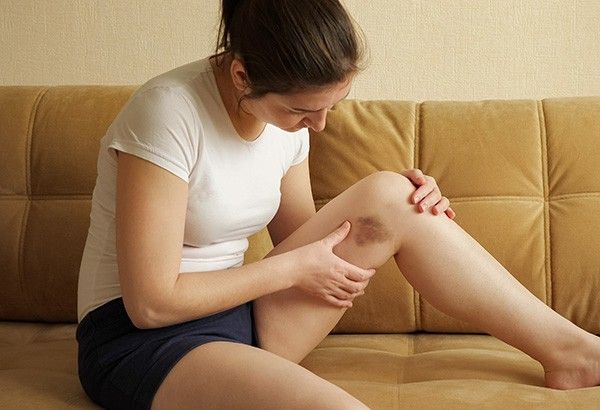LIST: Doctor sheds light to causes of bruises, rashes

MANILA, Philippines — Does a cut that takes as long as a week to heal should be a cause of concern?
Is a darkened neck or armpit a sign of any underlying condition? Do rashes that suddenly developed in one part of your body raise your alarm?
These are questions that some of us may have asked. To know if these are causes of concern, Dr. Rosalio Torres, Hematology section Chief at Makati Medical Center, enumerated the possible causes for these and gave advice if it is the right time to see a doctor.
Bruises
Women are more prone to bruising than men, as are the elderly, as the fatty layer that cushions their blood vessels thins as they age.
Bruises occur when a blow or impact to the body breaks the small blood vessels or capillaries near the surface of the skin, causing blood vessels to leak out and appear as black-and-blue marks. These eventually disappaers as the blood is reabsorbed by the body.
Dr. Torres also shared that bruises are also caused by certain medications such as aspirin, blood thinners, anti-platelet agents and even some antibiotics and herbal supplements that affect the blood's ability to clot. Corticosteroids prescribed for allergies, asthma, and eczema thin the skin, making it vulnerable to bruising.
Bruises also appear due to vigorous exercise because of the microscopic tears in the blood vessels brought about by intense training.
Von Willebrand Disease and Hemophilia are rare disorders (Von Willebrand disease for women and hemophilia for men) characterized by a lack of sufficient blood-clotting proteins or clotting factors.
“Deficiency in the proteins that help blood clot don’t just result in bruises but other symptoms such as nosebleeds, bleeding gums, and strong menstruation in women,” said Dr. Torres.
Jaundice
He also explained that jaundice, the yellowing of the skin and whites of the eyes, may also be an indicator of a blood disease. “This is caused by a bilirubin buildup, which is a waste material in the blood. This may be due to hemolytic anemia," he explained.
Nutrient deficiency
A lack of Vitamin C, Vitamin K and Vitamin B-12 may result in bruising, he said. Consult your doctor if you show other symptoms of Vitamin K deficiency like bleeding gums, blood in your stool, profuse menstrual flow and excessive bleeding from a wound.
Diabetes
“Diabetes per se does not cause bruising, but it slows down the healing of wounds and bruises,” Dr. Torres explained.
It is time to see your the doctor if the bruise is accompanied by other classic symptoms of diabetes: insatiable thirst and hunger, frequent urination, sudden weight loss, tingling or numbness in the hands or feet, and blurred vision.
Thrombophilia
“When your body produces too much clotting elements, you tend to form blood clots easily. This increases your risk of developing deep vein thrombosis (a blood clot in the vein of your leg) or pulmonary embolism (a blocked blood vessel in the lungs),” explained Dr. Torres.
Blood thinners are prescribed to patients with thrombophilia, and this makes them bruise easily.
Bruises normally go away on their own, he assured. But if a bruise doesn’t improve in two weeks, doesn’t disappear after three to four weeks, or if it is accompanied by some swelling and pain, see your doctor immediately.
Rashes
According to Dr. Torres, “A rash is a noticeable change in the texture and color of the skin. It’s an irritation that is usually red and can be dry, scaly, bumpy, itchy or slightly elevated.”
A number of conditions manifest in the form of rashes — from a simple diaper rash to fungal infections like ringworm and athlete’s foot and viral infections like chicken pox and measles and more serious disorders like lupus erythematosus.
“Hives are the most common type of rash, affecting one out of five people,” he said. “They appear suddenly and are often triggered by a specific allergen. The allergen prompts the body to release histamines, chemicals in the immune system that make you sneeze, tear up, or itch.”
Hives are also known as urticaria and wheals; angioedema is a type of hives that develops underneath the skin.
Though irritating, hives are relieved once the allergen is identified and removed, or after taking an antihistamine.
“See a doctor if the rash develops all over your body, is accompanied by a fever, begins to blister, and is painful,” Dr. Torres advised.



















